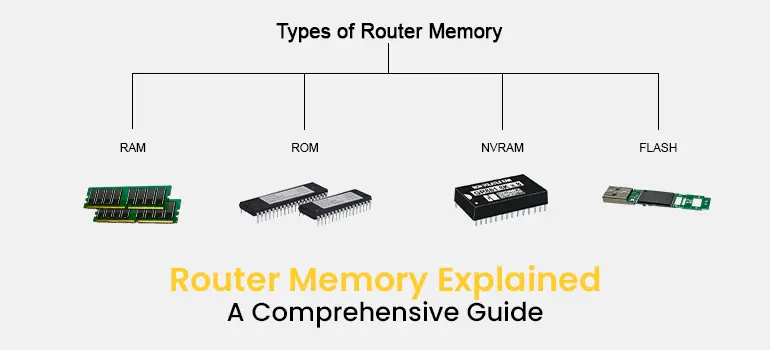Router Memory Explained: A Comprehensive Guide

Router memory plays a crucial role in the performance and functionality of networking devices. In this blog, we'll explore the different types of router memory, their functions, and how they impact network operations.
The external structure of a Cisco router might seem basic, but its memory components are where its operational core lies. Acting as a specialized computer, a Cisco router uses a customized operating system that focuses on routing tasks.
Unlike regular computers that use hard disk storage, Cisco routers utilize multiple memory types, such as Flash Memory, RAM, ROM, and NVRAM. This article aims to explain the importance of each memory area and its respective functions within a Cisco router.
RAM, or Random Access Memory, is a type of computer memory that is used to store data and machine code currently being used or processed by the CPU (Central Processing Unit). It allows for quick access to data, enabling fast read and write operations, which are essential for the smooth operation of programs and processes on a computer or networking device. RAM is volatile memory, meaning it requires power to maintain stored data, and it loses its contents when the power is turned off.
ROM, or Read-Only Memory, is a type of computer memory that stores data permanently. In Cisco routers, ROM is used to store critical firmware and bootstrap code essential for booting up the router and initializing its functions. Unlike RAM, ROM retains its contents even when the router is powered off, making it vital for the boot process and system stability.
ROM, or Read-Only Memory, plays a crucial role in the operation of Cisco routers, especially during the boot process. Here's a breakdown of its key components and functions:
Power-on Self-Test (POST): Upon booting up, ROM conducts a sequence called POST, ensuring that essential router components like the CPU, memory, and interfaces are functional.
Bootstrap Program: ROM contains a bootstrap program responsible for initializing the CPU and boot functions. It locates and loads the router's IOS (Internetwork Operating System) from Flash memory.
ROM Monitor: This special diagnostic environment aids in troubleshooting and special configurations. It allows tasks like transferring IOS images over console connections.
RxBoot: In situations where a valid IOS image isn't found in Flash or on a TFTP server, a limited IOS version, also known as RxBoot, is used. This version serves as a boot loader and facilitates the installation of a new IOS image into Flash.
Size and Upgrades: The ROM size in Cisco 2500 series routers is typically 2MB. Although ROM upgrades are rare, they involve replacing the physical chips on the router's motherboard. Moreover, ROM contents remain intact even when the router is powered down.
NVRAM, or Non-Volatile Random Access Memory, is a crucial component in Cisco routers, serving as the storage location for the startup configuration file.
In conclusion, understanding the intricacies of router memory is essential for optimizing network performance and ensuring reliable operation. From Flash memory storing the IOS software to NVRAM preserving critical configuration files, each memory type serves a vital role in the functionality of Cisco routers. By grasping the functions and limitations of Flash, RAM, ROM, and NVRAM, network administrators can effectively manage and troubleshoot router configurations.